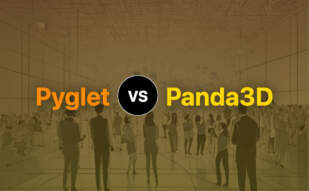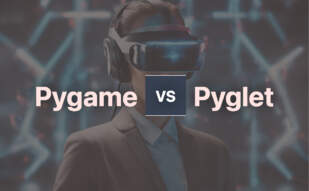Pyglet is an open-source Python library catering to various game development needs like GUI design, multimedia applications, and game creation. It boasts a full suite of features for windowing, user interface event handling, and multimedia support. With no external dependencies, it simplifies distribution and installation processes. Supporting both Python 2 and 3, Pyglet stands out with its efficient resource management and active developer community.

For those exploring alternatives to Pyglet, choices encompass Arcade, Pygame, Kivy, Tkinter, Panda3D, Turtle, Unity3D, Love2D, Unity, Ogre3D, OpenGL, Ursina.
Arcade

Marching to the beat of a different drum, we present Arcade, a profound creation of Paul Vincent Craven designed to upgrade the Python gaming universe. This groundbreaking library sings a new tune, challenging conventional norms and truly illustrating the magic you can craft with Python 3.6+ for building tantalizing 2D video games.
Best Features
- Creation of a bevy of geometrical shapes via inbuilt drawing functions.
- Daringly ditches traditional gaming norms with the Cartesian coordinate system
- Offers the wealth of the League system for embedding realistic motion.
- Introduces Sprites, empowering game developers to animate object generation.
- Features sound-support functions to soak your gaming landscape in robust audioscapes.
| Written in | Python (3.6 or newer) |
|---|---|
| Compatibility | Windows, Mac OS X, Linux (OpenGL 3.3+ needed) |
| Release | 2.4.3 version (2020) |
Arcade Downsides
- Works exclusively with Python 3.6 and above, displaying limited version adaptability.
- Prone to occasional instability and limited backward compatibility.
- Documentation could use a dash more finesse and ample dish of debugging.
Arcade Pricing
Keeping in sync with the rebel spirit, Arcade is completely free! Embrace the open-source mantra and let creativity vaunt!
Arcade Use Cases
Use case 1 – Indie Game Developers
Whether a novice or a dev-hermit, if game development stirs your creativity, Arcade simplifies your game-crafting journey, releasing you from the shackles of defining functions or classes for basic drawing.
Use case 2 – Academic Purposes
Arcade’s robust examples and tutorials make it a hot asset for educators, allowing them – and their students – to master the art of Python game development.
Use case 3 – Commercial Game Development
With its sprite feature, ability to insert audio and object-oriented design, Arcade paves the way for commercial game developers to create eye-catching and engaging games.
Pygame

Standing at the crossroads of video game development and Python programming, Pygame emerges as a power-packed ensemble of Python modules, laser-focused on creating video games.
Pygame Top Features
- Offers robust cross-platform capabilities.
- Utilizes the Simple DirectMedia Layer (SDL) library to simplify real-time game development.
- Equipped with functions like vector math, collision detection, and pixel-array manipulation.
- Extends compatibility to Android devices through Pygame Subset for Android (pgs4a) offering sound, vibration, keyboard, and accelerometer support.
- Community-driven development model invites users to create tutorials for upskilling newcomers.
| Aspect | Description |
|---|---|
| Portability | Runs on nearly every OS, game consoles, handheld devices, even OLPC computers. |
| Learning Curve | Easier and more accessible than many of its peers, Pygame proves beneficial for beginners, college students, and first-time programmers. |
| Performance | Pygame’s code performs 10-20x faster than Python, and an Assembly Language version exists that is 100x faster than Python code. |
Pygame Limitations
- Less suitable for large-scale complex game projects.
- Performance can vary on platforms outside Windows and macOS.
Pygame Pricing
As an open-source offering operating under GNU Lesser General Public License, Pygame is absolutely free for use.
Pygame Use Cases
Use case 1
Pygame’s simplicity, cross-platform abilities, speed, and ease of learning make it a top choice in academia for teaching programming and game development to students.
Use case 2
For indie game developers looking to test waters without investing too much, Pygame’s zero-cost model, supported by a vibrant community, proves immensely beneficial.
Use case 3
Its compact and speedy nature, along with wide OS compatibility, makes Pygame a viable tool for developing games for portable devices and low-end hardware.
OpenGL

OpenGL (Open Graphics Library), a brainchild of Silicon Graphics, has transformed the landscape of 3D graphics since its genesis in 1992. Born from the roots of the proprietary IRIS GL, today it stands united under the umbrella of the Khronos Group and a bastion of 150+ leading tech businesses. It has powered Augmented Reality, Virtual Reality, and gaming worlds and resonates with the rhythm of C++.
Top Features of OpenGL
- Designed for hardware-accelerated 3D graphics, breathing life into AR and VR sectors.
- A rich library for high-performance rendering and modelling.
- Heavily utilized across sectors including video games, CAD, and scientific applications.
- Fingerprints on commercial games, such as ID Software’s Quake series, with its graphics engines.
- Customizable, with features accessed via versions and extensions.
- Modern OpenGL versions, v3.3 and higher, exposed by ModernGL library.
- Vulkan API integration, bridging OpenGL and OpenGL ES.
| Visionary Approach | Key Updates |
|---|---|
| Keeping pace with industry needs | Specification updates allowing direct creation of binary blob for program objects, binding programs individually. |
| Adaptive with evolving needs | Extension additions ensuring forward compatibility and seamless integration. |
| Stellar Learning platform | Keeps users updated with industry-standard shader definition language SPIR-V and additional features. |
Downsides of OpenGL
- Demands prior knowledge of C++ programming language and understanding of math principles.
- Despite wide application, it still requires a deeper understanding of 3D graphical applications.
- Certain advanced hardware-specific features are only accessible via certain versions and extensions.
OpenGL Use Cases
Use case 1: Video Game Development
For those tapping into the gaming industry, OpenGL stands as a ready ally, having powered commercial games and resonating with the needs of game developers. Its powerful rendering and modelling capabilities can give your game life.
Use case 2: Augmented and Virtual Reality
Step into the future! With its designed support for AR and VR, OpenGL is the magic wand you need to create immersive visual experiences.
Use case 3: CAD and Scientific Applications
OpenGL empowers engineers and scientists to build intricate, detailed graphical models, explaining complex phenomena and designing the world of tomorrow.
Ursina

Launched as recently as 2019, Ursina is a free, open-source game engine, developed with Python and heavily based on the Panda3D library. Compatible with Linux and Windows, it’s a preferred choice for many due to its seamless compatibility with Photoshop and Blender.
Ursina Top Features
- Easy installation and quick game operation
- Real-time code and texture adjustment during game testing
- Capability to build detailed 2D and 3D games
- Comprehensive resources including tutorials, sample codes, and in-depth documentation
- Developing scene editor for interactive model placement
- Compatible with platforms like Godot, Unreal Engine, Unity
| Python-Based | Built in Python and C++, Ursina leverages the ease of Python, thus reducing the learning curve. It also supports C#, indicating its wide-scale language support. |
| Modern Integration | Ursina successfully integrates open-source navigation mesh, pathfinding libraries, and Graphical Logic Editor for efficient Python binding. |
| Sustainability | Despite the emergence of new engines, Ursina continues to hold its ground as a reliable tool in game development. |
Ursina Limitations
- While advantageous, Ursina’s reliance on Python may present a learning curve for non-Python users.
- As a fairly new engine, it’s possible that some features are less developed or inconsistent compared to older, more established game engines.
- Each frame in game loop implementation entails four major actions that may be laborious to some users.
Ursina Pricing
Being an open-source project, Ursina is available free of charge. Its goal is to foster creativity amongst developers worldwide without the burden of fees.
Ursina Use Cases
Use case 1
With its easy installation and Python-based architecture, Ursina can be an excellent tool for Python developers looking to venture into game development.
Use case 2
Designers working with Photoshop or Blender will find Ursina very user-friendly due to its seamless compatibility with these platforms.
Use case 3
For developers prioritizing sustainability, Ursina leaves a smaller digital footprint as an open-source engine, making it a green choice.
Kivy
Meet Kivy, a one-of-a-kind, open-source, Python-based framework, specially designed for creating multi-touch applications brimming with a natural user interface. It’s like Bob Ross for touchscreen apps, even down to the happy little buttons.
Kivy Top Features
- Cross-Platform Love:Kivy plays well with different platforms like Windows, macOS, Linux, iOS, and Android, making it the Switzerland of development frameworks.
- Dynamic, Responsive UI:With buttons, labels, and text inputs at its disposal, your user interface will feel more alive than a salsa dancing competition.
- Input Methods Galore: Ideal for touchscreen devices like smartphones and tablets, but it’s still chatty with mouses, keyboards, even gamepads!
- OpenGL Magic: Expect fast graphics rendering and visually appealing applications, because even codes deserve a makeover sometimes.
- Active Community: Kivy users form a tight-knit geek community, offering assistance, tutorials, and documentation. It’s like having a stack of nerdy guardian angels watching your back.
| Application Creation | Advantages |
|---|---|
| Involves inheriting Kivy’s App class, creating a build() method, and calling a run() method. | Provides Cross-platform functionality, a Natural user interface, Open-source code, Fast graphics rendering, and an MVC architecture. |
| Requires updating pip and wheel; installing necessary dependencies, followed by Kivy itself. | Offers better performance than HTML5 cross-platform alternatives. Keep Python 3 ready for action! |
Kivy Disadvantages
- Learning Curve: Kivy speaks native Pythonese, requiring some effort to master its unique lingo.
- Limited Third-Party Libraries: A bit of a drawback but hey, we all have our quirks!
- Performance Issues: Complex apps may stumble a bit. But then again, who doesn’t get tongue-tied when situations get complex?
Kivy Pricing
Bring out the party poppers, folks! Kivy is free! Just imagine, a world where high-performance software doesn’t cost a dime!
Kivy Use Cases
Use Case 1 – Mobile and Desktop App Development
Need an app that works seamlessly on your PC and smartphone? No worries. Kivy’s got your back with its cross-platform proficiency.
Use Case 2 – Touch-Based Applications
With excellent support for multiple touch and gesture interfaces, Kivy makes app navigation a smooth sail on touchscreen devices.
Use Case 3 – Dynamic UI Creation
If you’re yearning for an app with a responsive User Interface that reacts faster than a startled cat, Kivy’s dynamic buttons, labels and text inputs are what you need.
Tkinter
Created by the renowned Steen Lumholt and Guido van Rossum, Tkinter is Python’s de facto standard GUI. It’s a Python binding to the Tk GUI toolkit, implemented as a wrapper around a complete Tcl interpreter embedded in the Python interpreter.
Tkinter Top Features
- Standard Python interface to the Tk GUI toolkit, making it an integral part of Python installs on Linux, Windows, and macOS.
- Rich variety of widgets including frames, buttons, text, scrollbar, listbox, scale and more for diverse application development.
- Customisable Display Settings: Leveraging object-oriented paradigms to allow custom display settings for an improved reading experience.
- ‘Themed Tk’ functionality: Incorporated into Python 2.7 and Python 3.1 of Tk 8.5, this promotes native theming.
- Combination of Python and Tcl: Tkinter calls are translated into Tcl commands, enabling a mix of Python and Tcl in a single application.
| Highlight | Description |
|---|---|
| Free Software | Under the Python license, Tkinter is free for use by developers. |
| Pop-up Dialogs Modules | Modules such as tk.messagebox, tk.filedialog, and tk.colorchooser aid in creating interactive UIs. |
| Alternatives | Others in the lineup include Kivy, Pygame, Pyglet, PyGObject, PyQt, PySide, wxPython. |
Tkinter Limitations
- Learning curve: Beginners may find it challenging to navigate.
- UI Design: Less streamlined compared to modern GUI frameworks.
Tkinter Pricing
As a free software under the Python license, Tkinter doesn’t burn a hole in your pocket while you work towards creating your masterpiece applications.
Tkinter Use Cases
Use case 1: Desktop Applications
Tkinter’s feature-rich interface and comprehensive set of widgets enable developers to create interactive and robust desktop applications.
Use case 2: Game Prototyping
For game developers, Python’s standard GUI toolkit offers a variety of utilities and options to quickly prototype game interfaces.
Use case 3: Real-world Applications
With its versatility and wide range of widgets, Tkinter is a suitable choice for developing complex real-world applications in Python.
Panda3D

Emerging from the creative and imaginative umbrella of Disney Interactive, Panda3D is a powerful game engine built to facilitate 3D rendering and game development, leveraging the versatility of Python and C++. Open source and free to use, this engine first came to life in 2002, having its roots in Disney’s VR studio and VR research projects with universities.
Top Features of Panda3D
- 3D rendering: Engineered for creating graphically-rich games, offering modern per-pixel lighting techniques, custom shaders, gloss and normal maps.
- Python and C++ support: With its core written in C++, Python is used for scripting, ensuring both languages are fully supported.
- Extensive capabilities: Includes 3D audio using FMOD, OpenAL or Miles Sound System, physics system, collision detection, finite state machines, networking and AI.
| License | Revised BSD license |
| Organization Involved | Initiated by Disney Interactive, further development by Carnegie Mellon’s Entertainment Technology Center |
| Use Cases | Used for commercial games, university courses and open-source projects |
Limitations of Panda3D
- Not for beginners; requires a foundational understanding of Python and APIs.
- Does not natively support Android; although, there is an option for Android cross-compile.
Panda3D Pricing
One of the many appealing facets of Panda3D is its pricing model. As an open-source project, it is entirely free to use.
Panda3D Use Cases
Game Development
Thanks to a diverse array of functionalities, Panda3D serves as a go-to engine for developers of large commercial games such as Pirates of the Caribbean Online and Toontown Online.
Educational Use
In the academic sector, university courses often utilize Panda3D to teach students the intricacies of 3D game creation.
Open Source Projects
With its open source nature and free licensing, Panda3D proves ideal for open-source projects seeking a flexible and robust game engine.
Turtle
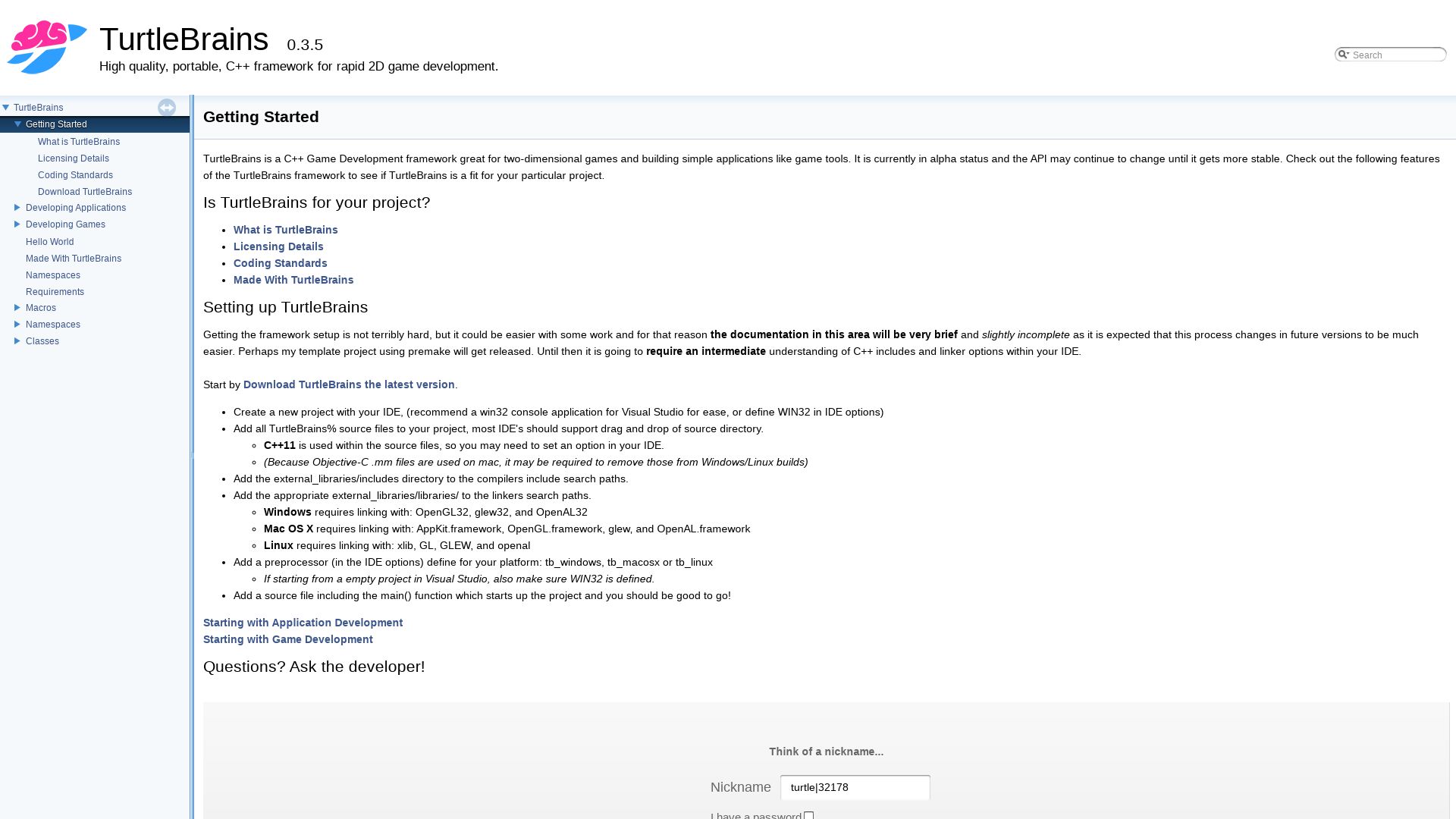
Meet Turtle, the classic programming tool spiced up with modern flavor. Originally invented by Seymour Papert and his team at MIT in the 60s, Turtle has evolved into a virtual object in contemporary programming languages like Python.
Turtle’s Best Features
- Easy to use Python syntax – provides an understandable and straightforward way to learn core programming concepts.
- Graphic management – with the facility to control a state of the pen, enabling creation of unique sketches or complex patterns.
- Built-in library in Python – makes it accessible on the get-go and encourages learning by doing.
- Greater functionality – you can move your Turtle forward, turn it, draw shapes, and create fractals!
- Creates both 2D and 3D – utilizing different coordinate systems, adds depth to your graphic learning journey!
| Feature | Benefit |
|---|---|
| Easy Learning Path | Helps children to effectively visualize the produced code |
| Graphic Libraries | Provides programmers an advantageous alternative to external graphic libraries |
| Present in Python’s Standard Library | Aids in familiarizing beginners with Python essentials |
Turtle Downsides
- Basic Turtle features may seem inadequate to seasoned programmers seeking advanced graphical output.
- Lack of advanced commands could limit the complexity of designs.
Turtle Use Cases
Use case 1
With basic to complex geometric shapes creation, Turtle is a boon for all the budding artists who dram of bringing shapes to life with a dash of code.
Use case 2
As in the Lindenmayer system for generating fractals, Turtle can be your go-to tool when you wish to paint with math!
Use case 3
For educationists trying to make programming fun for kids, Python’s Turtle library can be a game-changer. Imagine making learning Python an exciting graphical journey for the young minds!
Unity3D
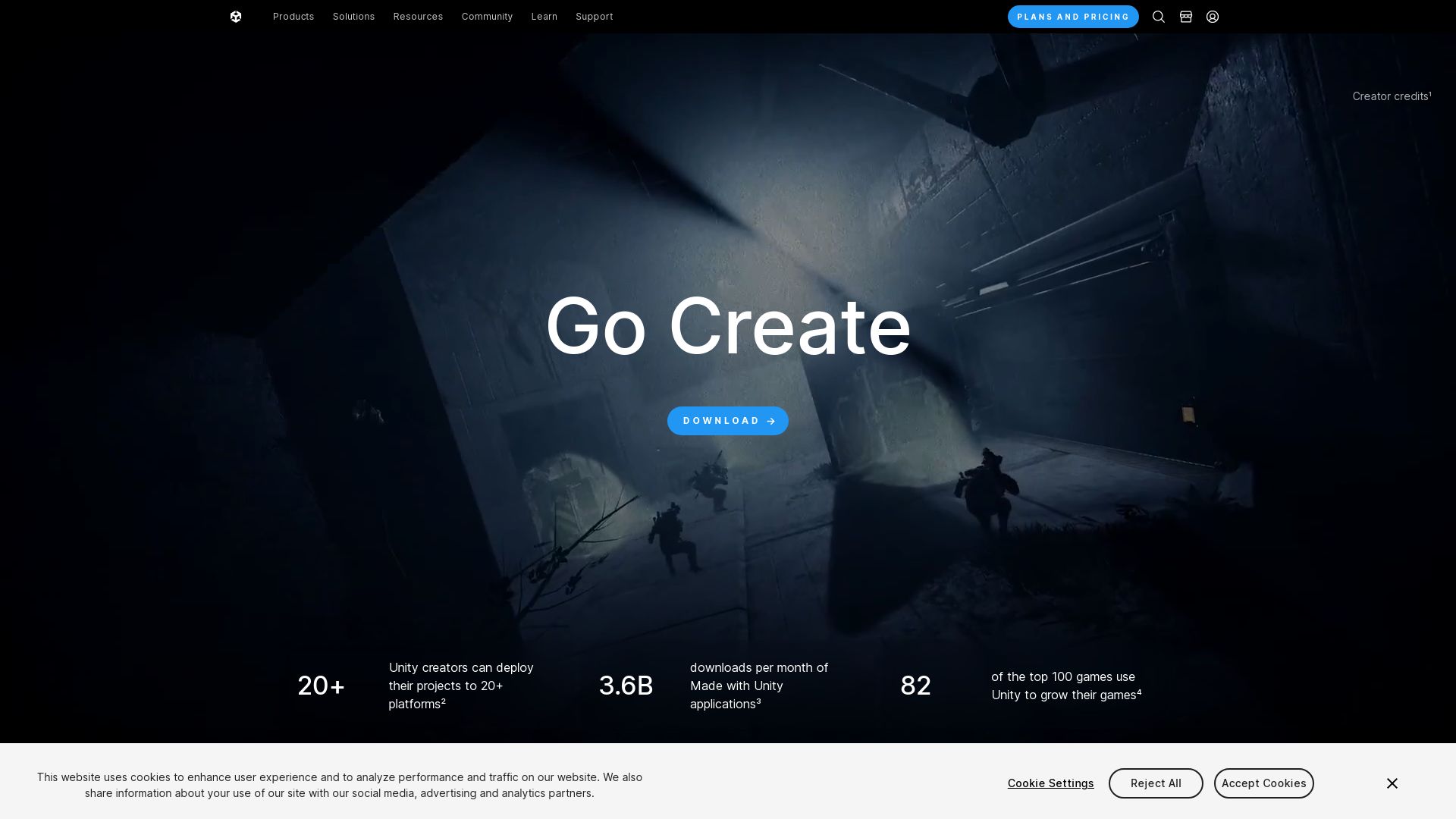
An established luminary in the galaxy of cross-platform game engines, Unity3D saw its genesis at the Apple Worldwide Developers Conference in June 2005. Initially launched as a Mac OS X game engine, Unity3D has metamorphosed into a robust platform that straddles various arenas, ranging from desktop, mobile, console, to virtual reality platforms.
Unity3D Top Features
- Support for diverse desktop, mobile, console, and virtual reality platforms.
- Perfect for beginner developers due to an user-friendly interface.
- Extensive support for iOS and Android mobile game development.
- Comprehensive 2D and 3D creation capabilities, utilizing the Box2D engine for 2D physics.
- Integration with Visual Studio, C# scripting API, JavaScript scripting language and Mono Develop IDE.
- A vast array of scripts, models, scenery, materials, and other items on the Unity marketplace.
| Year | Launch |
|---|---|
| 2007 | Unity 2.0 |
| 2010 | Unity 3.0 |
| 2012 | Unity 4.0 |
| 2015 | Unity 5.0 |
Unity3D Limitations
- Political changes and pricing policy modifications have sparked notable backlash from the user community.
- Eligibility for use is contingent on financial details such as revenue thresholds.
- Required ‘Per Install’ fee applicable from January 1, 2024, based on game installations.
- Fierce competition from rivals like Unreal, Godot, etc.
Unity3D Pricing
Unity3D comes with plans tailored for students, personal use, and enterprises. Different versions bear varying price tags, capping at $1500. However, their commercial terms are most economical for game development up to a revenue threshold of $200,000.
Unity3D Use Cases
Use case 1: Mobile Game Development
Its cross-platform support and mobile-oriented development features make Unity3D a desirable choice for mobile game developers, particularly in the iOS and Android spheres.
Use case 2: Indie Game Development
With its user-friendly interface and a wide range of creative capabilities, Unity 3D bolsters independent, or indie, game creators to bring their visions alive.
Use case 3: Non-Gaming Industries
Unity3D transcends the gaming industry, finding resonance in fields like film, automotive, architecture, engineering, construction, and U.S. Armed Forces for varied applications.
Love2D
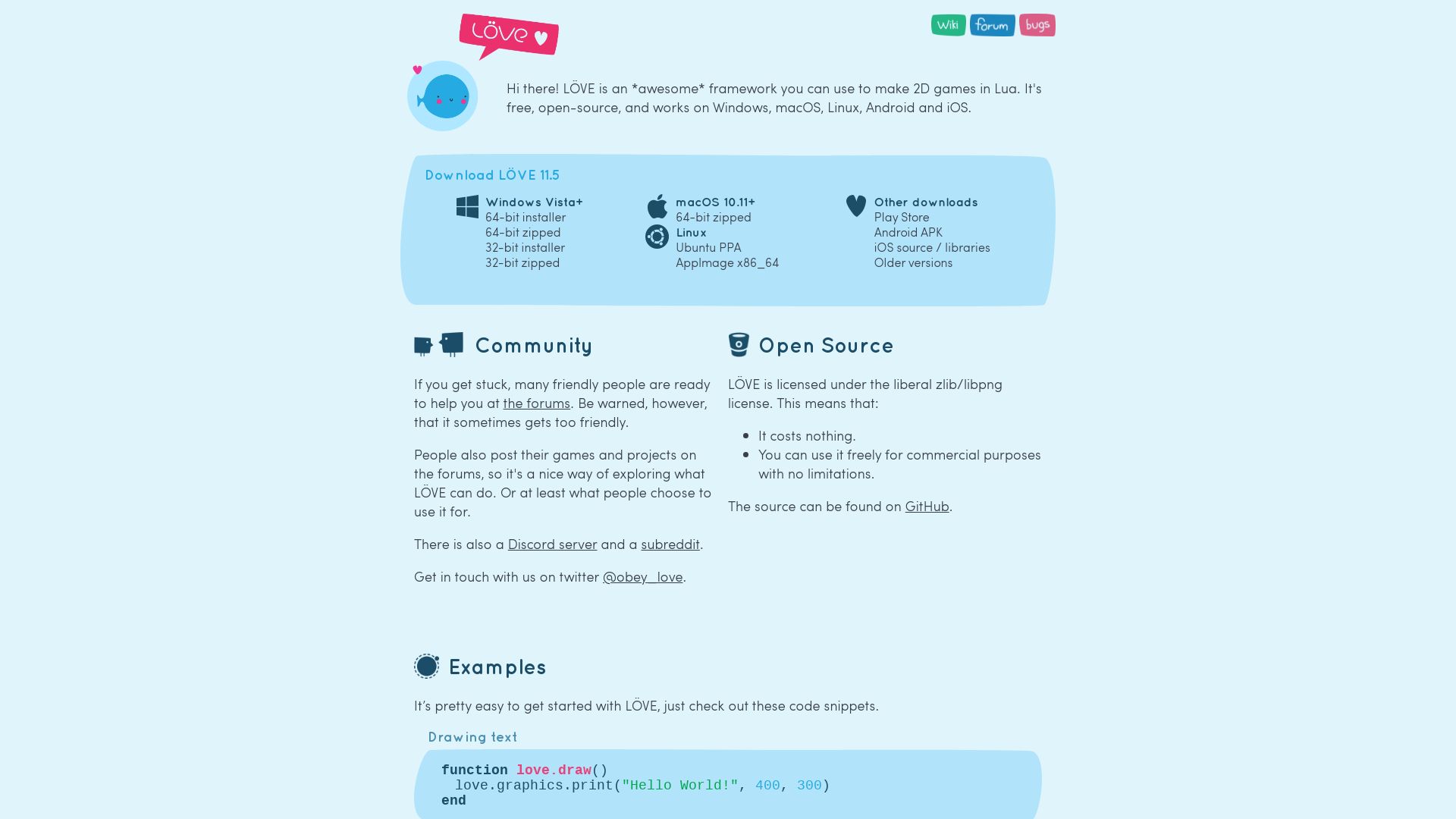
Immerse yourself in the vibrant world of Love2D, a free open-source game framework initially released in 2008. Stir up your creativity with this tool written in C++, marked for its extraordinary features and an extensive compatibility across platforms.
Love2D Stellar Features
- Employs Lua scripting language, delivering a seamless game programming experience.
- Exceptional support for libraries SDL and OpenGL – an absolute game-changer.
- Runs on FreeBSD, OpenBSD, NetBSD, Windows, Linux, macOS, iOS, Android, which means no platform restriction.
- Lavishes user with OpenGL pixel shaders GLSL, touchscreens support for mobile devices, joystick controls, and UTF-8 capabilities.
| Supports Formats | Complimented with libraries |
| Audio: WAV, OGG, MP3 Image: PNG, JPEG, GIF, TGA, BMP |
Physics engine Box2D, LuaSocket library for network communications |
| Move or Die, Mari0, Kingdom Rush, BYTEPATH, Blue Revolver, Warlock’s Tower | LIKO-12, Lutro, ChaiLove, love.js |
Love2D Limitations
- While powerful, LÖVE mainly caters to 2D games. It doesn’t quite have the firepower compared to Unreal and Unity.
- Its cross-platform functionality comes without guarantee for games working between different LÖVE versions.
- It incorporates limited modules, while lacking a graphical interface- a possible concern for novices.
Love2D Pricing
Brace yourself for a pleasant surprise. Love2D is absolutely free and open source, an opportunity for all willing developers!
Love2D Use Cases
Use case 1: Game Development Competitions
With Love2D, you can steal the spotlight at game development competitions like Ludum Dare. Its flexibility permits you to roll an impressive game in no time.
Use case 2: Indie Game Developers
Indie game developers find a welcoming environment in Love2D’s community-focused approach. Exceptional community support ensures you never hit a dead-end in your game designing journey.
Use case 3: Educational Settings
With its user-friendly Lua scripting, Love2D is an excellent learning tool in educational settings. It transforms programming lessons into an engaging exploration, even for beginners!
Unity

Launched in 2005, Unity has emerged as a robust game development engine, enabling the creation of both 2D and 3D games. Capable of launching cross-platform games including Android and iOS platforms, Unity is adaptable with a range of operating systems and can facilitate everything from Augmented Reality applications to immersive 3D simulations.
Unity Top Features
- Cross-Platform Compatibility: Allows developers to create games for various platforms including Android and iOS.
- Diverse Game Development: Supports a broad spectrum of applications from Augmented Reality to 3D simulations.
- Rich Asset Store: Integrated with a variety of pre-designed textures and features encouraging creative game designs.
- Active Developer Community: Facilitates mutual assistance, problem-solving, and feedback for system improvements.
- Range of Coding Languages: Offers compatibility with multiple coding languages such as BOO script, Javascript, and C#.
| Feature | Description |
|---|---|
| Fraud Detection Practices | Planned methods to prevent developers from incurring costs for pirated copies. |
| Evolution | Engages user base in constant learning and implementation of new industry solutions and platforms for open communication. |
| Collaboration | Seeks to foster adaptability and collaboration among members, enhancing the strength of game development. |
Unity Disadvantages
- Pricing Model: The planned per-install fee model has been met with backlash, especially from solo and mobile developers.
- Retroactive Fees: Announcement of retroactive fees triggered open mistrust among users.
- Dismissal of Unity Plus: Discontinuation of Unity Plus subscription tier has further complicated the pricing structure.
- Sudden Policy Changes: Unannounced shifts in pricing and policies have led to diminished trust among users.
Unity Pricing
Unity has undergone several pricing model changes over the years. The most recent model charges a per-install fee from developers each time a Unity-based game is installed. This approach drew backlash from developers. However, Unity has clarified that until their game exceeds $200,000 in revenue and surpasses 200,000 installations, developers won’t be charged an install fee. A new pricing model will be implemented starting January 1, 2024.
Unity Use Cases
VR/AR Development
With its capability of creating AR and VR games, Unity is a fitting choice for developers keen on producing immersive games.
Indie Game Development
Despite the backlash regarding pricing, Unity provides a free version with considerable features and an active developer community, making it a viable option for indie developers.
3D Simulations
Those interested in creating 3D simulations will benefit from Unity’s rich asset store and powerful rendering technology.
Ogre3D

Ogre3D is a polygon-crunching powerhorse, designed to let developers create visually rich hardware-accelerated 3D graphics applications. Written in C++, this API-friendly engine is swathed in a coherent design and bolstered by consistently updated documentation.
Ogre3D Top Features
- Flexibility: Can be used for both business apps and games.
- Integration-friendly: Supports the integration of different libraries such as sound, networking, AI, collision, and physics.
- Pioneering Tech: Features integrated bump and offset mapping, shadows, physically based shading, particle effects, and much more.
- Cross-Platform: Ported to various platforms including Windows, macOS, Linux, Xbox, and PS3.
| Highlight | Detail |
|---|---|
| Development History | Began in 1999 and has progressively evolved with expanded features and updated versions. |
| Licensing | Uses MIT License allowing for commercial distribution and modification. |
| Demos | Available through Emscripten, Linux Snap, F-Droid App, etc. |
Ogre3D Limitations
- Physics Engine: Ambiguity about the specific functionalities provided.
- Turn-Based Gaming Preference: It might affect real-time gaming experiences.
- Rather techy: Might be a steep learning curve for beginners in 3D programming.
Ogre3D Pricing
With a commitment to the open-source ethos, Ogre3D is available for free. While this implies zero financial investment, users are encouraged to contribute with plugins, bugfixes, tutorials, and much more.
Ogre3D Use Cases
Use case 1 – Game Development
With its capabilities to render complex 3D graphics, Ogre3D makes for an ideal choice in game development, as proven by games like Rebel Galaxy and Roblox.
Use case 2 – Business Applications
Not restricted to games, Ogre3D’s integration-friendly API enables it to be used in building various business applications and simulations.
Use case 3 – Open-Source Projects
Backed by an active community, Ogre3D can foster numerous open-source projects, stirring innovation while taking feedback and contributions from users around the world.
Patrick Daugherty
Content writer @ Aircada. Merging AR expertise with a love for late-night gaming sessions.



